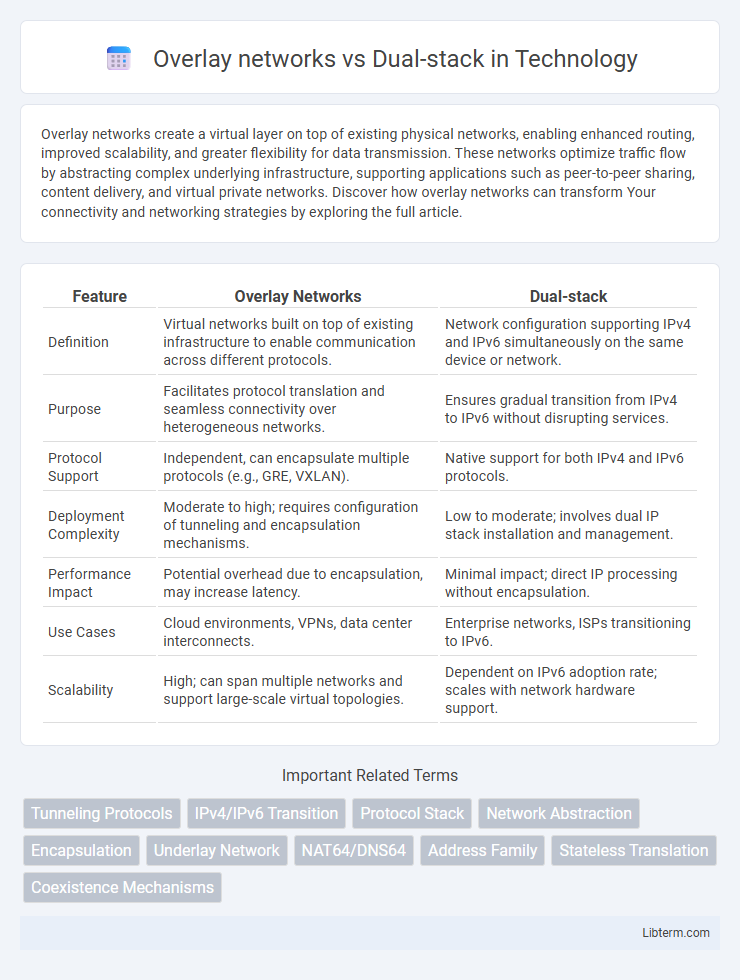Overlay networks create a virtual layer on top of existing physical networks, enabling enhanced routing, improved scalability, and greater flexibility for data transmission. These networks optimize traffic flow by abstracting complex underlying infrastructure, supporting applications such as peer-to-peer sharing, content delivery, and virtual private networks. Discover how overlay networks can transform Your connectivity and networking strategies by exploring the full article.
Table of Comparison
| Feature | Overlay Networks | Dual-stack |
|---|---|---|
| Definition | Virtual networks built on top of existing infrastructure to enable communication across different protocols. | Network configuration supporting IPv4 and IPv6 simultaneously on the same device or network. |
| Purpose | Facilitates protocol translation and seamless connectivity over heterogeneous networks. | Ensures gradual transition from IPv4 to IPv6 without disrupting services. |
| Protocol Support | Independent, can encapsulate multiple protocols (e.g., GRE, VXLAN). | Native support for both IPv4 and IPv6 protocols. |
| Deployment Complexity | Moderate to high; requires configuration of tunneling and encapsulation mechanisms. | Low to moderate; involves dual IP stack installation and management. |
| Performance Impact | Potential overhead due to encapsulation, may increase latency. | Minimal impact; direct IP processing without encapsulation. |
| Use Cases | Cloud environments, VPNs, data center interconnects. | Enterprise networks, ISPs transitioning to IPv6. |
| Scalability | High; can span multiple networks and support large-scale virtual topologies. | Dependent on IPv6 adoption rate; scales with network hardware support. |
Introduction to Overlay Networks and Dual-Stack
Overlay networks create a virtual network layered on top of existing networks, enabling enhanced routing, security, and scalability without altering the underlying infrastructure. Dual-stack technology allows devices to run both IPv4 and IPv6 protocols simultaneously, facilitating seamless communication during the transition from IPv4 to IPv6. Overlay networks offer flexibility in network design, while dual-stack ensures compatibility and interoperability across IP versions.
Core Concepts: Overlay Networks
Overlay networks create a virtualized network layer on top of existing physical infrastructure, enabling greater flexibility and scalability by encapsulating packets within another protocol. They separate the logical topology from the underlying hardware, supporting features such as virtual private networks (VPNs), software-defined networking (SDN), and multicast routing. This abstraction simplifies network management and enhances connectivity across diverse environments without modifying the core network architecture.
Core Concepts: Dual-Stack Approach
The Dual-Stack Approach enables simultaneous support for IPv4 and IPv6 protocols by running both protocol stacks on network devices, facilitating seamless communication across mixed environments. This method allows devices to transmit and receive packets using either IP version, ensuring compatibility during the transition period from IPv4 to IPv6. Key benefits include simplified network management and improved interoperability without the need for complex tunneling mechanisms common in overlay networks.
Architecture Comparison: Overlay vs Dual-Stack
Overlay networks use encapsulation to run multiple network protocols over a shared infrastructure, separating the underlying physical layer from virtual network layers, which enhances flexibility and scalability. Dual-stack architecture operates by enabling devices to run IPv4 and IPv6 simultaneously on the same network hardware, allowing for gradual IPv6 adoption without disrupting existing IPv4 services. Overlay networks provide abstraction and simplified management across heterogeneous environments, while dual-stack maintains native protocol support side-by-side, impacting deployment complexity and network performance differently.
Deployment Scenarios for Overlay Networks
Overlay networks excel in deployment scenarios requiring rapid scalability and isolation, such as multi-tenant cloud environments and data center virtualization. They enable seamless IP address management and traffic segmentation without altering underlying physical infrastructure, making them ideal for hybrid and multi-cloud deployments. Unlike dual-stack solutions, overlay networks support heterogeneous network protocols and enhance network agility by abstracting complexity from the physical layer.
Deployment Scenarios for Dual-Stack
Dual-stack deployment is ideal for environments transitioning from IPv4 to IPv6, enabling seamless communication across both protocols without significant infrastructure changes. It supports gradual adoption by allowing devices and applications to use either IPv4 or IPv6 based on network availability, enhancing compatibility in heterogeneous networks. This approach suits enterprises and service providers requiring simultaneous support for legacy IPv4 and emerging IPv6 traffic during migration phases.
Performance and Scalability Considerations
Overlay networks reduce complexity by encapsulating traffic, allowing scalable Layer 2 connectivity over Layer 3, but can introduce latency and processing overhead affecting performance. Dual-stack enables native IPv4 and IPv6 operation on the same device, offering lower latency and better performance by avoiding encapsulation, though it requires maintaining two protocol stacks, which can impact scalability. Performance in overlay networks depends on tunneling efficiency, while dual-stack scalability may be limited by operational complexity and resource consumption for supporting both protocols concurrently.
Security Implications: Overlay vs Dual-Stack
Overlay networks separate security domains by encapsulating traffic within encrypted tunnels, enhancing isolation and reducing exposure to external threats. Dual-stack configurations expose devices to vulnerabilities inherent in both IPv4 and IPv6 protocols, increasing the attack surface and requiring robust firewall and monitoring strategies for each stack. While overlay networks simplify enforcement of security policies through centralized control, dual-stack environments demand extensive coordination to mitigate risks across heterogeneous address families.
Use Cases and Real-World Examples
Overlay networks enable seamless integration of IPv6 over existing IPv4 infrastructure, ideal for organizations transitioning to IPv6 without immediate hardware upgrades; examples include Teredo and 6rd used by ISPs to provide IPv6 connectivity. Dual-stack deployment allows simultaneous support for both IPv4 and IPv6 on network devices, widely adopted by enterprises and cloud providers like Google and Microsoft to ensure compatibility and gradual migration. Overlay networks suit scenarios demanding quick IPv6 adoption over legacy systems, while dual-stack is preferred for environments requiring native protocol support and full dual connectivity.
Choosing the Right Solution: Overlay Networks or Dual-Stack
Overlay networks provide a flexible solution for IPv4 and IPv6 coexistence by encapsulating packets, minimizing the need for extensive infrastructure changes. Dual-stack enables native support for both protocols simultaneously, offering better performance and compatibility but requires significant network device upgrades. Selecting the right approach depends on factors like existing hardware capabilities, scalability requirements, and long-term network evolution plans.
Overlay networks Infographic

 libterm.com
libterm.com